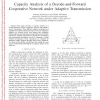Free Online Productivity Tools
i2Speak
i2Symbol
i2OCR
iTex2Img
iWeb2Print
iWeb2Shot
i2Type
iPdf2Split
iPdf2Merge
i2Bopomofo
i2Arabic
i2Style
i2Image
i2PDF
iLatex2Rtf
Sci2ools
105
Voted
CCECE
2009
IEEE
2009
IEEE
Capacity analysis of a decode-and-forward cooperative network under adaptive transmission
—This paper presents a capacity analysis of a decode-and-forward (DF) cooperative network with adaptive source transmission. Three different adaptive techniques are considered: (i) optimal simultaneous power and rate adaptation (OPRA); (ii) constant power with optimal rate adaptation (ORA); (iii) truncated channel inversion with fixed rate (TIFR). Closed form capacity expressions are derived for non-identical and independently distributed (non-i.i.d.) Nakagami-m fading wireless environments. These expressions are validated by simulation results obtained through Monte Carlo simulation. It is observed that OPRA and ORA provide roughly the same capacity, while TIFR yields slightly less capacity relative to the other two.
| Added | 21 Jul 2010 |
| Updated | 21 Jul 2010 |
| Type | Conference |
| Year | 2009 |
| Where | CCECE |
| Authors | Prasanna Kalansuriya, Chintha Tellambura |
Comments (0)

